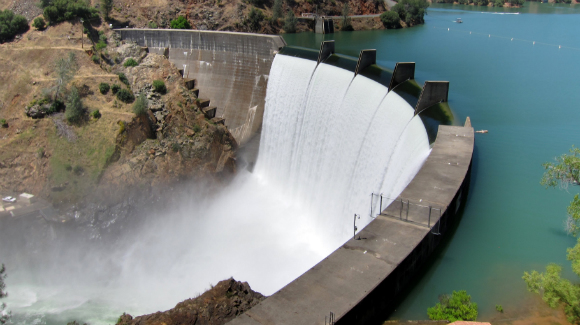
Englebright dam on the Yuba River in the Sacramento River Basin. (Photo Credit: Amit Patel/Flickr)
California’s water debate was turned on its head twice this week. First, when a $10.5 billion bond, which had grown in size by 50 percent since May in order to win key votes, failed on the Senate floor. Then, when the governor took things in the opposite direction the next day, finally joining negotiations over how to raise the money needed to invest in the state’s aging water infrastructure—and outlining a plan to put a much smaller, $6 billion bond on the November ballot.
These moments of refreshingly public debate—which revealed major disagreements in the Legislature over everything from new dams to Delta restoration and the governor’s tunnel project—had an expected result, with the state’s water conversation quickly moving back behind closed doors. Lawmakers and stakeholders are expected to continue haggling over the bond’s size—and exactly how much borrowing voters will support—before another round of votes next week.
The size of the bond is certainly important, but it’s not the only thing that matters. Whether the final measure is $6 billion or $10 billion, whether it has $2 billion for storage (as the governor has proposed) or $3 billion (as Senate Republicans have demanded), what’s most important to voters is how these funds will be used to ensure billions in water projects solve California’s long-term water issues—and prevent the state from lurching from water crisis to water crisis.
This is the case the Summit has been making since February, when it outlined 11 recommendations for the state to respond to drought in sustainable ways. There’s no question investment in California’s aging water system is desperately needed: As a recent PPIC study found, more than $30 billion is spent every year on water in California, but the state is underfunding a range of vital water projects, from flood control to stormwater management, by $2 to $3 billion every year. This has not only left a million Californians without access to clean drinking water—and many more vulnerable to natural disaster—it is also a measure of the missed opportunity to adopt time-tested approaches to water use that can prepare the state for a drier future.
The goal: Addressing California’s long-term water challenges
For the Summit, though, the water bond has never been about just encouraging certain types of water projects. The governor’s single-page water bond term sheet outlines all of the same kinds of projects detailed in the $10.5 billion bond that failed on Monday—from water recycling and wastewater treatment to storage and ecosystem restoration.
The Legislature’s real task, in crafting a bond, is to ensure billions in funding goes to projects that will address California’s most pressing water challenge: achieving the state’s “coequal goals” of developing a more reliable water supply and protecting, restoring, and enhancing the Delta ecosystem. In its February letter to the governor and legislative leaders, the Summit argued that the best way to accomplish this was by advancing the new paradigm in which the state sets goals and regions compete on a performance basis to craft strategies that deliver results. The letter acknowledged that this would require a comprehensive solution—one that simultaneously reduces demand (via conservation and water-use efficiency, for example), while also improving supply (making integrated water infrastructure investments that better link natural watersheds with storage and conveyance systems).
While not all of these projects can—or should—be funded in a general obligation bond, the Summit urged lawmakers to draft a bond that encouraged water projects to integrate their work across city boundaries—or, even better, entire watersheds—and then allow state agencies to direct public funds to the projects that produce the most benefit at the lowest cost.
So how much water will this week’s versions of a water bond buy—and how effective will they be at addressing the state’s long-term water challenges? “If lawmakers think drought is a good time to borrow money to pay for public projects, they need a good answer to that question,” wrote California Forward’s Jim Mayer earlier this year. “It is probably unreasonable to expect there to be a number in gallons…Still, there should be assurances that the billions spent will be spent on projects that directly increase water supplies and reliability, or heal environmental damage caused by existing or future water supply projects.”
Where the money will go
The governor clearly has his own ideas about how to frame this debate: He refers to his proposal in the broadest possible terms as the “Water Action Plan Financing Act of 2014”—an allusion to his own comprehensive state water strategy, a far-reaching plan for achieving the state’s coequal water goals.
To their credit, though, the authors of the half-dozen bond proposals still floating through the Capitol have also wrestled with these ideas for almost a year—including, in particular, measures authored by Asm. Anthony Rendon (AB 1331) and Sen. Lois Wolk (whose SB 848 was defeated on the Senate floor this week). In both bills, Rendon and Wolk have crafted a number of creative ways for distributing funds to encourage projects that will cost less while doing more to solve the state’s water problems—from making groundwater projects eligible for storage funding to finding new ways to distribute money across watersheds to encourage integrated water management.
As the governor wades into the water debate, the size of the water bond—as well as its impact on his proposed Delta tunnels—may have become the top issue once again.
But as negotiations continue—and the July 3 deadline legislators have to put the bond on the November ballot approaches—lawmakers should keep in mind that, for voters, there is something that may be even more important: how all of this money will be spent.

